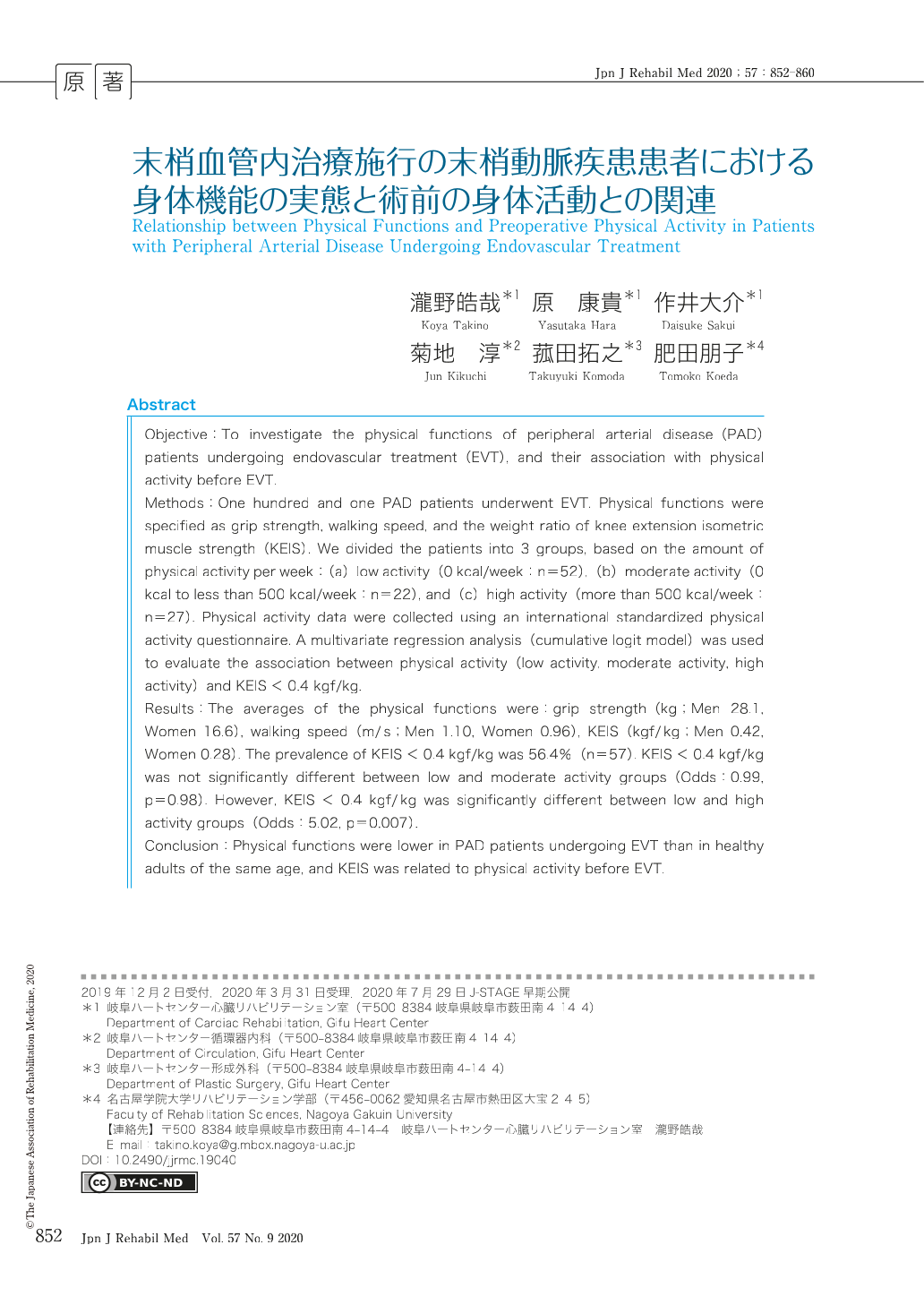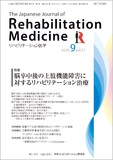Japanese
English
- 販売していません
- Abstract 文献概要
- 1ページ目 Look Inside
- 参考文献 Reference
要旨
目的:血管内治療(EVT)を受ける末梢動脈疾患(PAD)患者の身体機能の実態およびEVT術前の身体活動との関連について明らかにする.
方法:対象はEVTを受けたPAD患者101例.身体機能は握力,歩行速度,等尺性膝伸展筋力体重比とした.国際標準化身体活動質問票を用いて1週間の身体活動より低活動(0kcal/週:n=52),中程度活動(0kcal以上500kcal未満/週:n=22),高活動(500kcal以上/週:n=27)の3群へ分類した.歩行障害質問票(WIQ)にて間欠性跛行症状を評価した.身体活動を従属変数,等尺性膝伸展筋力体重比0.4kgf/kg未満,年齢,性別,WIQを独立変数とした多変量解析(累積ロジットモデル)を行った.
結果:身体機能の実態は握力(kg;男性28.1,女性16.6),歩行速度(m/s;男性1.1,女性0.96),等尺性膝伸展筋力体重比(kgf/kg;男性0.42,女性0.28)であった.また,等尺性膝伸展筋力体重比0.4kgf/kg未満の割合は56.4%であった.等尺性膝伸展筋力体重比0.4kgf/kgは低活動と中程度活動(odds:0.99,p=0.98)群間において関連を認めなかったものの,低活動と高活動群間(odds:5.02,p=0.007)に関連する因子であった.
結論:EVTを受けるPAD患者の身体機能は低下しており,下肢筋力低下はEVT術前の身体活動の関連因子であった.
Objective:To investigate the physical functions of peripheral arterial disease (PAD) patients undergoing endovascular treatment (EVT), and their association with physical activity before EVT.
Methods:One hundred and one PAD patients underwent EVT. Physical functions were specified as grip strength, walking speed, and the weight ratio of knee extension isometric muscle strength (KEIS). We divided the patients into 3 groups, based on the amount of physical activity per week:(a) low activity (0 kcal/week:n=52), (b)moderate activity (0 kcal to less than 500 kcal/week:n=22), and (c) high activity (more than 500 kcal/week:n=27). Physical activity data were collected using an international standardized physical activity questionnaire. A multivariate regression analysis (cumulative logit model) was used to evaluate the association between physical activity (low activity, moderate activity, high activity) and KEIS<0.4 kgf/kg.
Results:The averages of the physical functions were:grip strength (kg;Men 28.1, Women 16.6), walking speed (m/s;Men 1.10, Women 0.96), KEIS (kgf/kg;Men 0.42, Women 0.28). The prevalence of KEIS<0.4 kgf/kg was 56.4% (n=57). KEIS<0.4 kgf/kg was not significantly different between low and moderate activity groups (Odds:0.99, p=0.98). However, KEIS<0.4 kgf/kg was significantly different between low and high activity groups (Odds:5.02, p=0.007).
Conclusion:Physical functions were lower in PAD patients undergoing EVT than in healthy adults of the same age, and KEIS was related to physical activity before EVT.

Copyright © 2020, The Japanese Association of Rehabilitation Medicine. All rights reserved.


